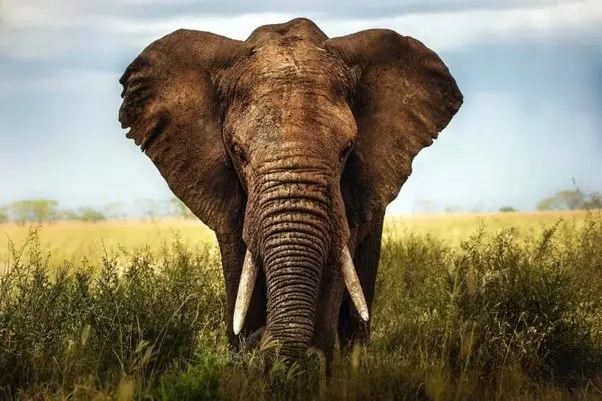Elephants do not have double vision in the same sense that humans sometimes experience it. While humans have binocular vision, which allows us to perceive depth and have a single, unified visual field, elephants have monocular vision, meaning their eyes work independently of each other.
- Eye Structure and Placement:
Elephants have large, forward-facing eyes positioned on the sides of their heads. This placement provides them with a wide field of view, allowing them to detect movement and potential threats from various directions. However, due to the position of their eyes, their visual fields do not overlap to the extent that humans’ binocular vision does. - Lack of Binocular Vision:
Binocular vision relies on the overlapping visual fields of both eyes to create a three-dimensional perception of the world. This depth perception allows humans to judge distances accurately. In contrast, elephants’ monocular vision means that each eye sees a slightly different view of the world. - Importance of Monocular Vision for Elephants:
Monocular vision is not a disadvantage for elephants but rather an adaptation that suits their needs. Elephants rely on their excellent sense of smell, acute hearing, and other sensory cues to navigate their environment effectively. They have evolved to thrive in their specific habitats, which include a variety of landscapes such as forests, savannas, and grasslands. - Visual Perception in Elephants:
While elephants may not have the same depth perception as humans, they possess remarkable visual capabilities in other respects. Their eyesight is well-suited for their lifestyle and allows them to perform essential tasks:a. Long-Distance Vision: Elephants have relatively good long-distance vision. They can spot other elephants or potential threats from afar, allowing them to communicate and maintain social connections within their herds.b. Color Perception: Elephants have dichromatic color vision, meaning they can perceive colors within the blue and green spectrum but have limited ability to distinguish between reds and oranges. However, they compensate for this with their acute senses of smell and hearing.c. Night Vision: Elephants have adapted to low-light conditions and possess good night vision. They have a high number of rod cells in their eyes, which are more sensitive to dim light, enabling them to navigate and forage during the darker hours.d. Visual Communication: Elephants use visual displays and body language as part of their communication repertoire. They can convey information and emotions through the position and movement of their ears, trunk, and body posture. - Depth Perception in Elephants:
While elephants do not have the same depth perception as humans, they can still gauge distances to some extent. They rely on multiple sensory inputs, such as sound, smell, and touch, in combination with their visual cues to navigate their environment accurately. - Adaptations for Size Perception:
Elephants’ size and physicality present unique challenges for depth perception. Their large body size and long trunk could potentially obstruct their view of the ground directly in front of them. To compensate, elephants employ a combination of visual and tactile cues. They use their sensitive trunks to explore and touch objects, providing them with additional information about their surroundings and helping them judge distances more accurately.
In summary, elephants do not have double vision as humans sometimes experience it. Instead, they have monocular vision, where their eyes work independently of each other. This adaptation allows elephants to have a wide field of view and detect movement from various directions. While they may lack the depth perception provided by binocular vision, elephants compensate for this with their acute senses of smell and hearing, as well as their ability to utilize visual, tactile, and other sensory cues to navigate their environment effectively.
Here are some additional details about elephants’ vision and how they perceive the world:
- Peripheral Vision: Elephants have an exceptional range of peripheral vision, thanks to the position and size of their eyes. Their eyes are located on the sides of their heads, providing them with an almost 360-degree field of view. This wide peripheral vision is advantageous for detecting predators, other elephants, and potential threats in their surroundings.
- Eye Structure: The anatomy of an elephant’s eye is similar to that of other mammals. They have a cornea, iris, lens, and retina. However, some unique features are worth noting:a. Eyelashes: Elephants have long, thick eyelashes that help protect their eyes from dust, debris, and insects.b. Eyelids: Elephants have both upper and lower eyelids, which they can close to shield their eyes from harsh sunlight or sand. They can also blink their eyes to keep them moist and clean.c. Pupil Shape: The pupil of an elephant’s eye is circular, unlike the vertical slit found in many other predators. This circular shape allows more light to enter the eye, enhancing their low-light vision.
- Visual Acuity: While elephants have good long-distance vision, their visual acuity for fine details is relatively limited compared to humans. They are better equipped to perceive movement and shapes rather than intricate details. However, their visual acuity is still sufficient for tasks such as recognizing other elephants, detecting predators, and identifying potential food sources.
- Sensory Integration: Elephants rely on an integration of various sensory inputs to make sense of their environment. While their visual perception may be less prominent than in humans, they compensate by using their highly developed senses of smell, hearing, and touch. These sensory inputs work together to provide a comprehensive understanding of their surroundings.
- Environmental Adaptations: Elephants have adapted to a variety of habitats, from open grasslands to dense forests. These different environments present varying levels of visibility and lighting conditions. Elephants’ visual systems have evolved to accommodate these diverse habitats, allowing them to navigate effectively in both bright daylight and low-light conditions.
- Individual Differences: It is worth noting that there can be variations in visual capabilities among individual elephants, just as there are variations in any species. Factors such as age, health, and genetics can influence an elephant’s vision, potentially leading to variations in visual acuity or perception.
While it is true that elephants do not have the same depth perception as humans due to their monocular vision, they have evolved a range of adaptations that allow them to thrive in their natural habitats. Their visual system, combined with their other highly developed senses, enables them to perceive their surroundings, communicate with other elephants, and navigate their environment effectively.
Can elephants see colors, or are they limited to black and white vision?
Elephants can see colors, although their color vision is not as extensive as that of humans. They have dichromatic color vision, meaning they can perceive colors within a limited range of the spectrum.
- Color Perception:
Elephants have two types of color receptors or cones in their eyes—short-wavelength sensitive cones (also known as “blue cones”) and long-wavelength sensitive cones (also known as “green cones”). This means they can distinguish between shades of blue and green, but their ability to differentiate between colors in the red and orange range is limited. - Blue and Green Perception:
Research suggests that elephants have a higher sensitivity to the blue part of the color spectrum. They can perceive various shades of blue, ranging from light blue to darker hues. Along with blue, they are also capable of perceiving shades of green, which is likely important for their ability to identify vegetation and foliage in their natural habitat. - Limited Red and Orange Perception:
While elephants can see some shades of red and orange, their color discrimination in this part of the spectrum is not as well-developed as in humans. Colors that appear vibrant or distinct to humans may appear more muted or similar to elephants. However, it’s important to note that elephants have compensatory sensory abilities, such as their excellent sense of smell and acute hearing, which help them gather information about their environment. - Adaptations for Color Perception:
The limited color vision of elephants is thought to be related to their natural habitat and ecological needs. Their vision has evolved to prioritize detecting movement, perceiving shapes, and discerning important visual cues in their environment rather than fine color discrimination. - Importance of Other Senses:
While elephants may have limited color vision, they rely on their other highly developed senses, such as their acute sense of smell and hearing, to gather information about their surroundings. These senses play a critical role in their foraging, communication, and social interactions.
In summary, elephants do have color vision, but it is limited compared to humans. They can perceive shades of blue and green but have a reduced ability to differentiate between colors in the red and orange range. Their visual system is adapted to prioritize other visual cues and sensory inputs, allowing them to navigate their environment effectively and fulfill their ecological needs.
How does the color vision of elephants compare to humans and other animals in their ecosystem?
The color vision of elephants, like many other aspects of their visual perception, is adapted to suit their specific ecological needs. While elephants have dichromatic color vision and can perceive certain colors, their color vision may differ from other animals within their ecosystem. Here’s a comparison of elephants’ color vision with some other notable animals in their habitats:
- Humans:
Humans possess trichromatic color vision, thanks to having three types of cones in their eyes that are sensitive to different parts of the color spectrum: red, green, and blue. This trichromatic vision allows humans to perceive a wide range of colors and color combinations. Compared to humans, elephants have limited color discrimination, particularly in the red and orange range of the spectrum. - Primates:
Many primates, including humans, have trichromatic color vision similar to humans. This allows them to perceive a broad range of colors and is advantageous for tasks such as identifying ripe fruits and distinguishing subtle color variations in their environments. - Birds:
Birds, particularly those that rely on colorful plumage for courtship and mating displays, often possess tetrachromatic or even pentachromatic color vision. Birds have additional types of color receptors in their eyes, which extend their color perception into the ultraviolet range. This enhanced color vision allows birds to see a broader spectrum of colors and detect fine color details. - Carnivores:
Carnivores, such as lions and hyenas, generally have dichromatic color vision, similar to elephants. They are typically more sensitive to blues and greens, but their ability to perceive colors in the red and orange range is limited. However, it’s worth noting that color vision may vary among different carnivore species. - Herbivores:
Many herbivores, including ungulates like elephants, have dichromatic or limited trichromatic color vision. Their color vision is adapted to prioritize detecting movement, perceiving shapes, and discerning important visual cues related to their feeding and social behavior. While specific details of color vision may vary among different herbivore species, they generally have visual systems that are well-suited for their ecological needs.
It’s important to recognize that color vision is just one aspect of visual perception, and animals have adapted their visual systems to prioritize different aspects based on their ecological roles and environments. For elephants, their visual system, including their color vision, is well-adapted to their specific lifestyle as large herbivores in diverse habitats. While they may have limited color discrimination compared to some other animals, elephants make use of their other sensory abilities, such as their keen sense of smell and acute hearing, to gather information and navigate their environment effectively.



